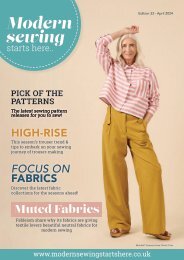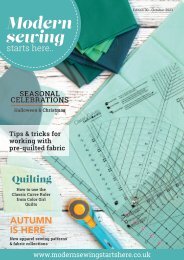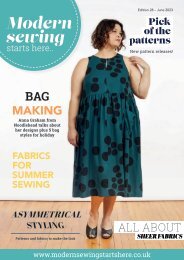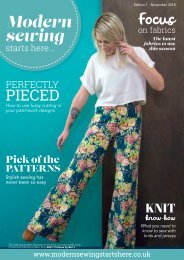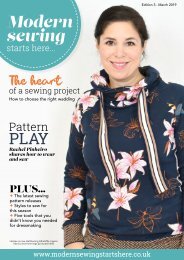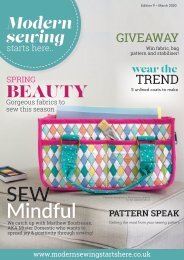Modern Sewing Starts Here Edition 23
Modern Sewing Starts Here is the digital publication which features articles, reviews and handy tips for anyone with an interest in contemporary sewing In this edition ... Liesl Gibson talks trend, sewing and style Hantex co founder, Jacqui Smith uses Ramie fabric to make Sewhouse Seven's Wildwood wrap dress On Trend - Bag Styes For This Season! Hit The Mark - Julie Bonnar discusses pattern markings and how to transfer them to your fabric. Best Sellers ... Which patterns have been super popular recently? Pick Of The Patterns ... Focus On Fabrics ... + More ...
Modern Sewing Starts Here is the digital publication which features articles, reviews and handy tips for anyone with an interest in contemporary sewing
In this edition ...
Liesl Gibson talks trend, sewing and style
Hantex co founder, Jacqui Smith uses Ramie fabric to make Sewhouse Seven's Wildwood wrap dress
On Trend - Bag Styes For This Season!
Hit The Mark - Julie Bonnar discusses pattern markings and how to transfer them to your fabric.
Best Sellers ... Which patterns have been super popular recently?
Pick Of The Patterns ...
Focus On Fabrics ... + More ...
Create successful ePaper yourself
Turn your PDF publications into a flip-book with our unique Google optimized e-Paper software.
Pintucks<br />
These are marked with straight lines on the pattern and are a way of manipulating the fabric so it can be brought together to form<br />
a tuck. Usually these pattern pieces can look a larger size or a weird shape, as they will be folded. Mark pintuck lines on your fabric<br />
with a removable pen or tailor’s chalk on the right side of the fabric using a ruler to create evenly spaced lines.<br />
TIP: Make sewing these easier with a pintuck presser<br />
foot, and sew your pintucks flat before construction.<br />
This foot has evenly spaced grooves on the bottom,<br />
and when used with a twin needle, it creates evenly<br />
spaced raised tucks of fabric. It will have 3, 5, 7, or 9<br />
grooves on the bottom, and which one you choose<br />
depends on the fabric weight being sewn. The finer<br />
the fabric – the smaller the pintuck will be, and the<br />
more grooves there are to accommodate this.<br />
FABRIC FOLDS:<br />
Pleats<br />
The symbol for pleats tells you to fold the fabric in the direction of the arrow matching<br />
the vertical lines. When circles are present, they are an additional marking to match.<br />
Buttonholes<br />
There are two markings. The buttonhole<br />
placement is marked with a straight line<br />
with closed ends. Transfer onto your fabric<br />
pieces with chalk or tailor’s tacks. These<br />
always sit horizontally so the buttonhole<br />
doesn’t pull and open easily! A buttonhole<br />
presser foot is the quickest way of sewing<br />
a neat buttonhole.<br />
The closed ends show how long the<br />
button should be. A cross will indicate<br />
where the button needs to be sewn.<br />
Always mark these when your fabric is flat.<br />
NB: A bust point is also marked with a<br />
circle with a cross or X in the middle to<br />
show the centre bust point or apex. You<br />
don’t need to transfer this point to your<br />
fabric and is treated as reference point to<br />
help you make any fit adjustments to your<br />
pattern before cutting.<br />
TOOLS, TOOLS, TOOLS!<br />
There are lots of tools on the market to choose from, so let’s<br />
look at the more common ones:<br />
Tailor’s Chalk & Pencils<br />
Tailor’s chalk slabs or triangles are<br />
available in several colours – red, white,<br />
yellow and blue. These are inexpensive,<br />
last longer than pencils, and are easy<br />
to use and easy to brush off the fabric.<br />
Choose the colour that stands out the<br />
most on your fabric.<br />
Chalk pencils are easy to sharpen and<br />
draw in hemlines, dart legs, pockets and<br />
anything where you need to see a finer<br />
stitching line.<br />
Marking Pens<br />
There are lots of pens available on the market including air or water-soluble,<br />
which disappear from the fabric. These are really popular but more expensive<br />
than its chalk counterpart.<br />
TIP: Test on your fabric first, and also remember air-soluble pens only last for<br />
around 24 hours, so only use if you intend to sew straight away!<br />
Tracing Wheel & Dressmaker’s Carbon Paper<br />
This is a more traditional way to mark. The carbon paper sits between the pattern<br />
and the wrong side of the fabric with the coloured side of the carbon paper facing<br />
the wrong side. Using the tracing wheel roll over the pattern marks and when<br />
the pattern is peeled back, there’ll be a row of dots on your fabric. This is a good<br />
method if you’re working with a difficult or thicker fabric.<br />
TIP: You can also get a double wheel tracer, which is handy for marking a seam<br />
allowance as the wheels sit approx. 1.5cm apart!<br />
For more marking tools – click here



